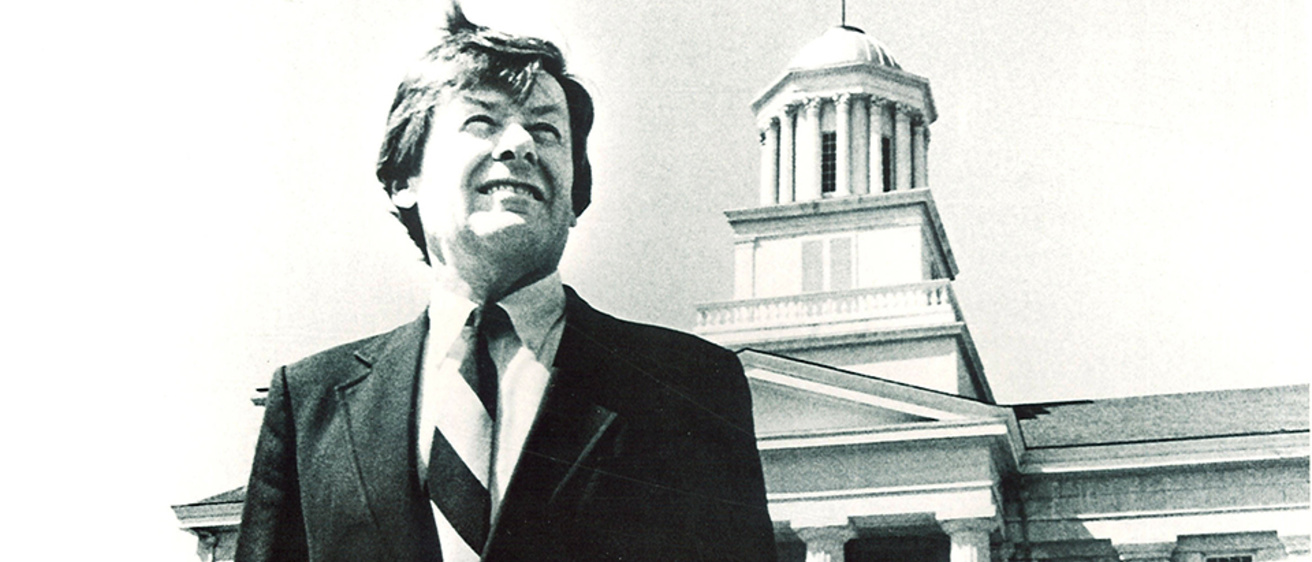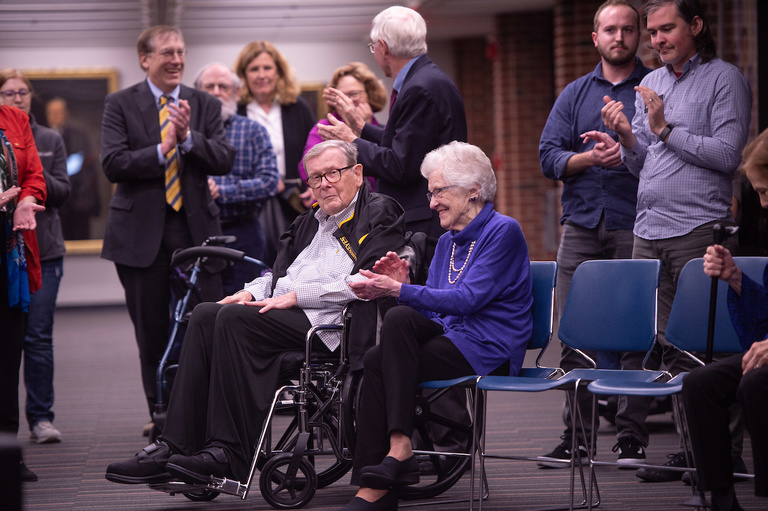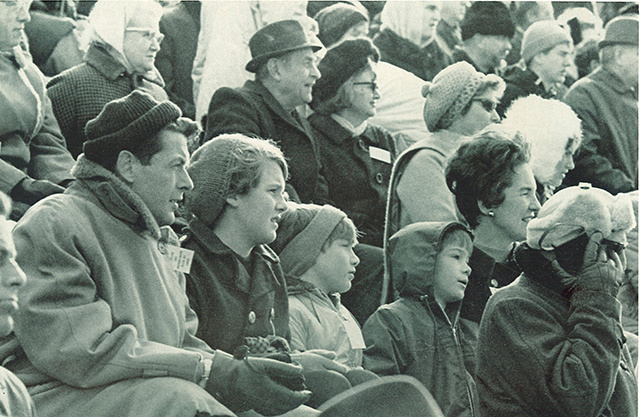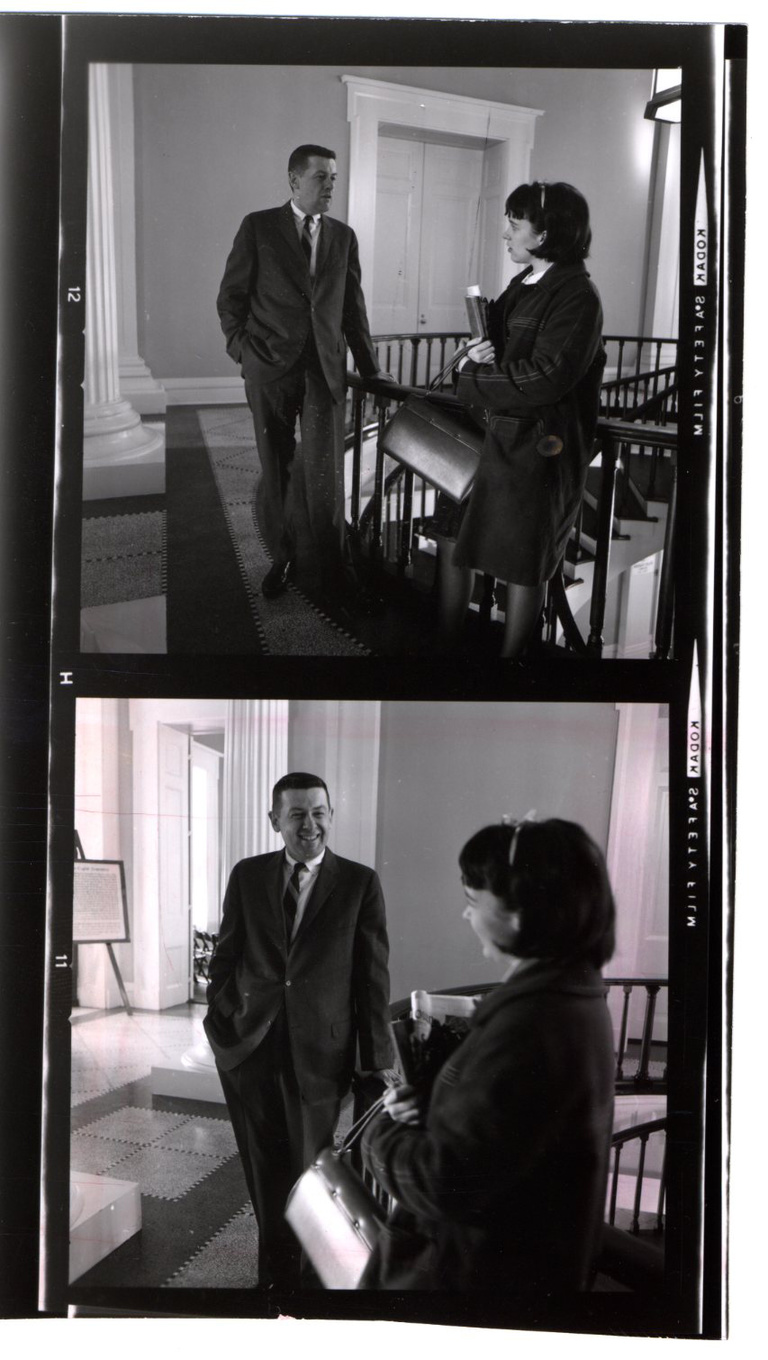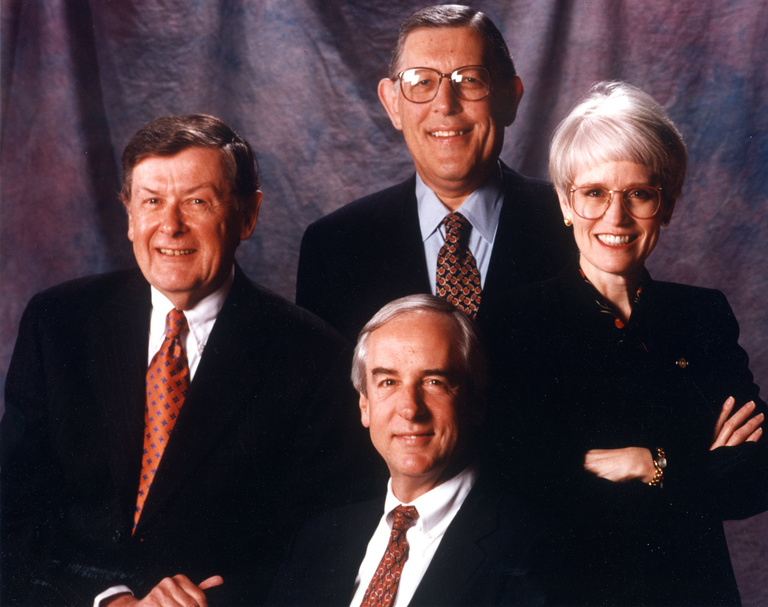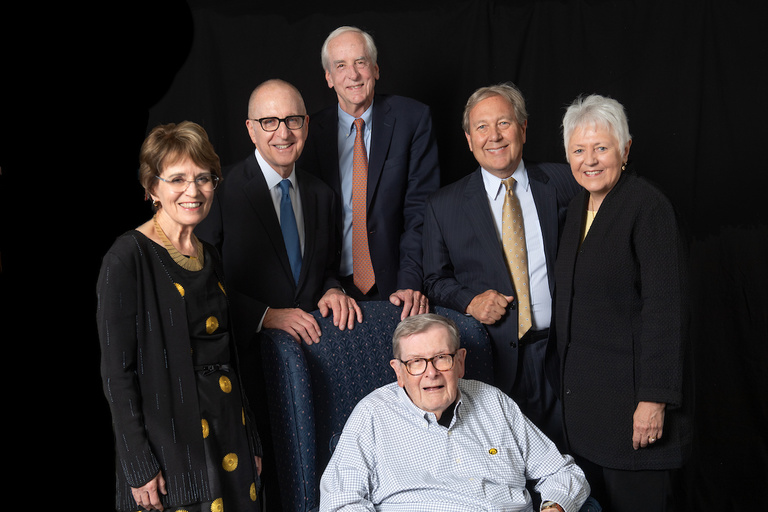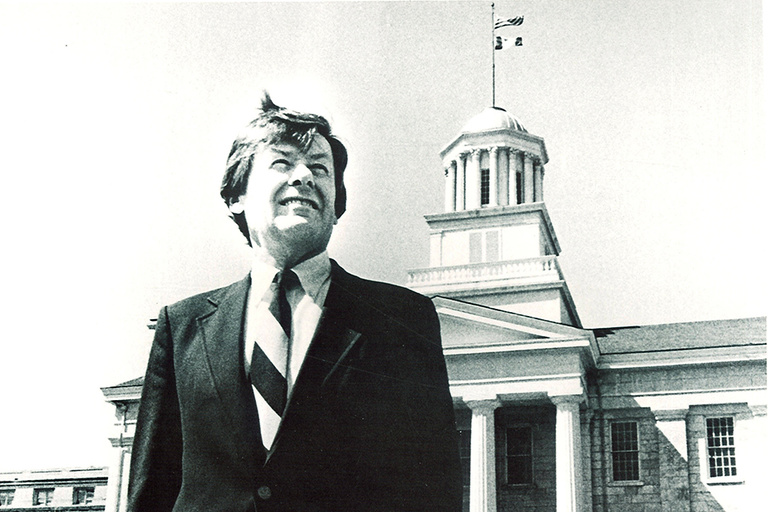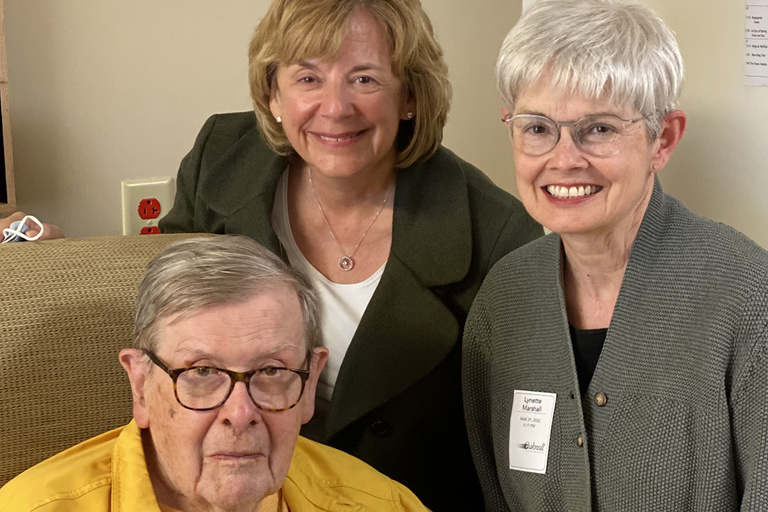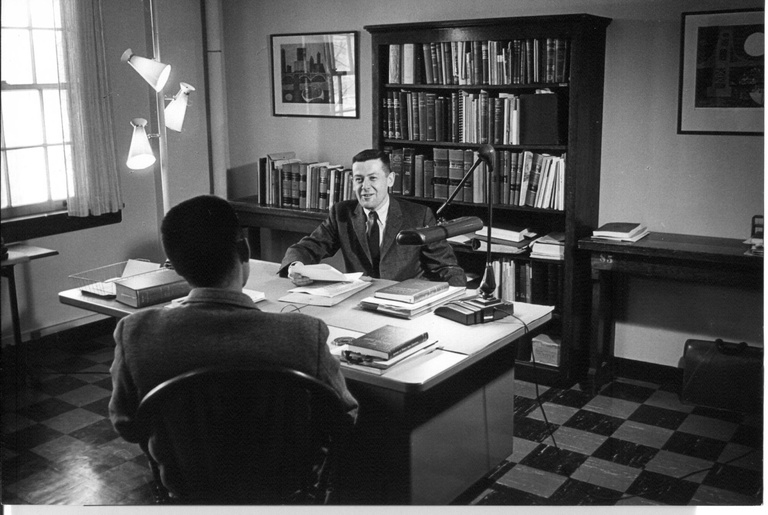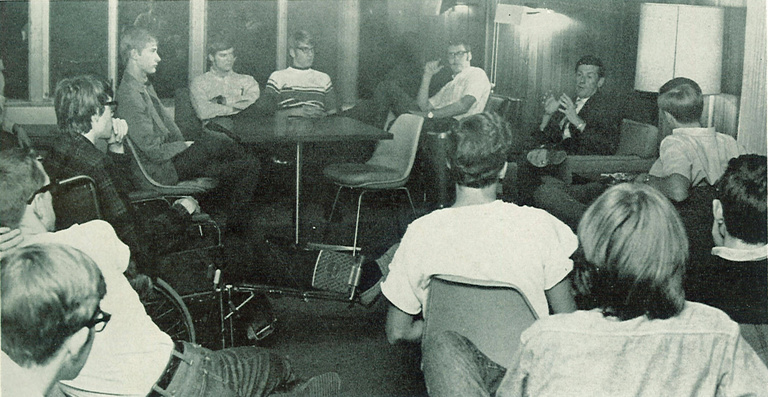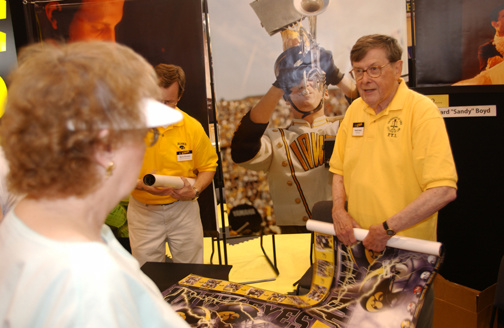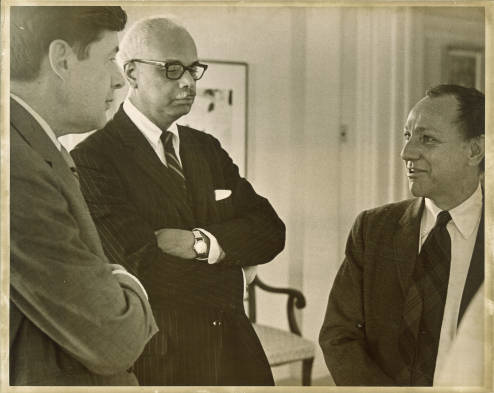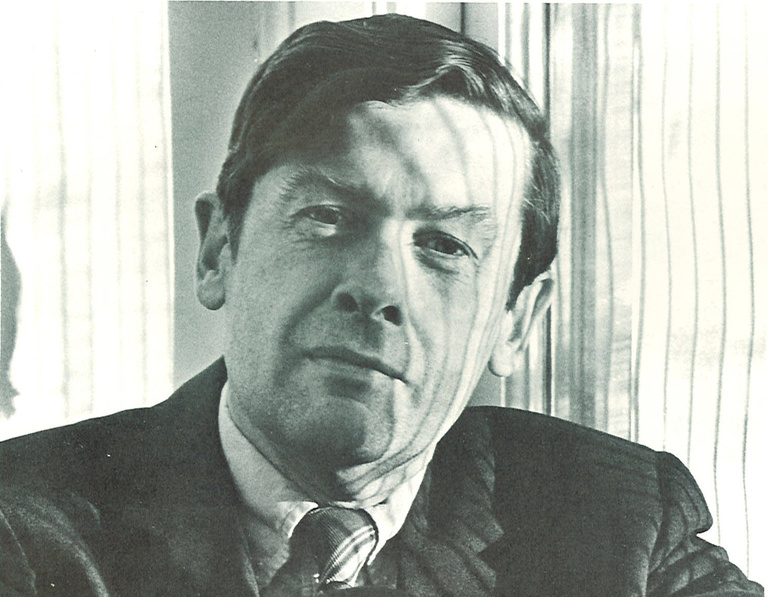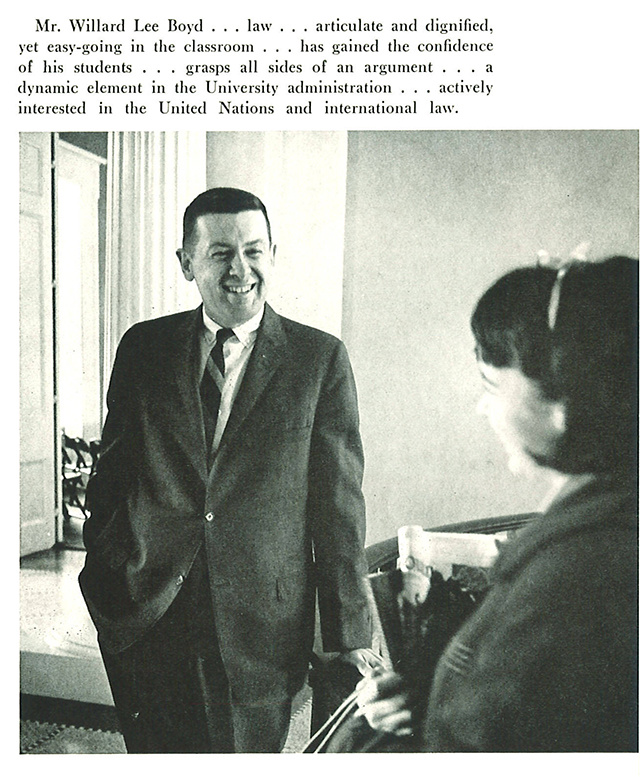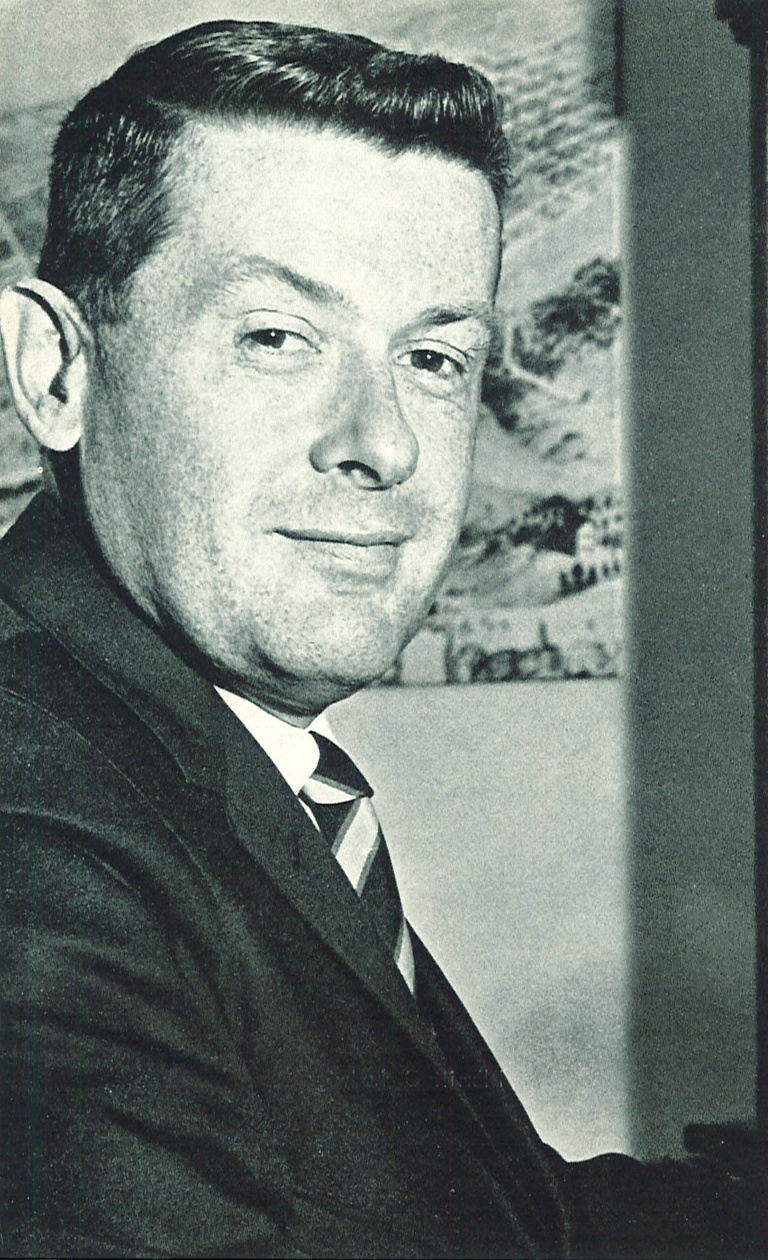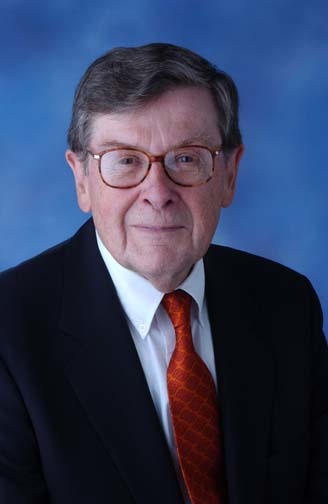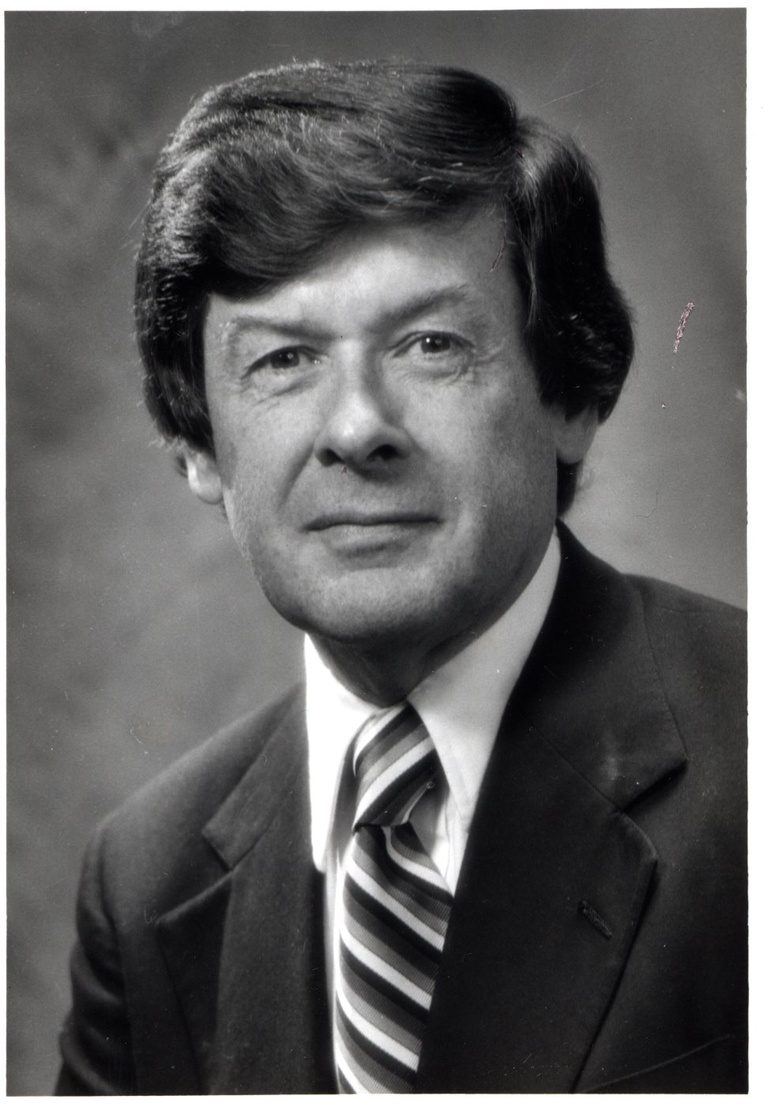The path of Willard “Sandy” Boyd’s life was set early.
His father, Willard Boyd Sr., was a faculty member at the University of Minnesota College of Agriculture, and his family grew up near the university’s ag school campus in St. Paul. The elder Boyd frequently traveled the state teaching more efficient methods of crop and livestock management, assistance craved by farmers pushed to the brink by the Great Depression.
The younger Boyd occasionally accompanied his father on these road trips, watching him work with often desperate people while his kindness and decency never wavered. Those trips profoundly influenced Sandy’s life.
“It instilled in me at a very young age the importance of public service and the value of giving people the tools that make their lives better,” Boyd said in 2007.
His commitment to public service spanned nearly nine decades, including more than 65 years of service to the University of Iowa, twice as president, and as law professor, champion, and never-ending friend. Boyd died Tuesday, Dec. 13, 2022, in Iowa City. He was 95.
“Sandy was beloved by the entire university community, and he will always remain one of the major figures in University of Iowa history. His impact and influence are deeply embedded in the character and excellence of this institution to this day. He represented who and what we are as an institution with integrity, grace, compassion, humor, and humanity, and he changed the university—and our society—for the better in profound and lasting ways,” says UI President Barbara Wilson. “Our deepest sympathies go out to his entire family, as well as all who loved and cared for him.”
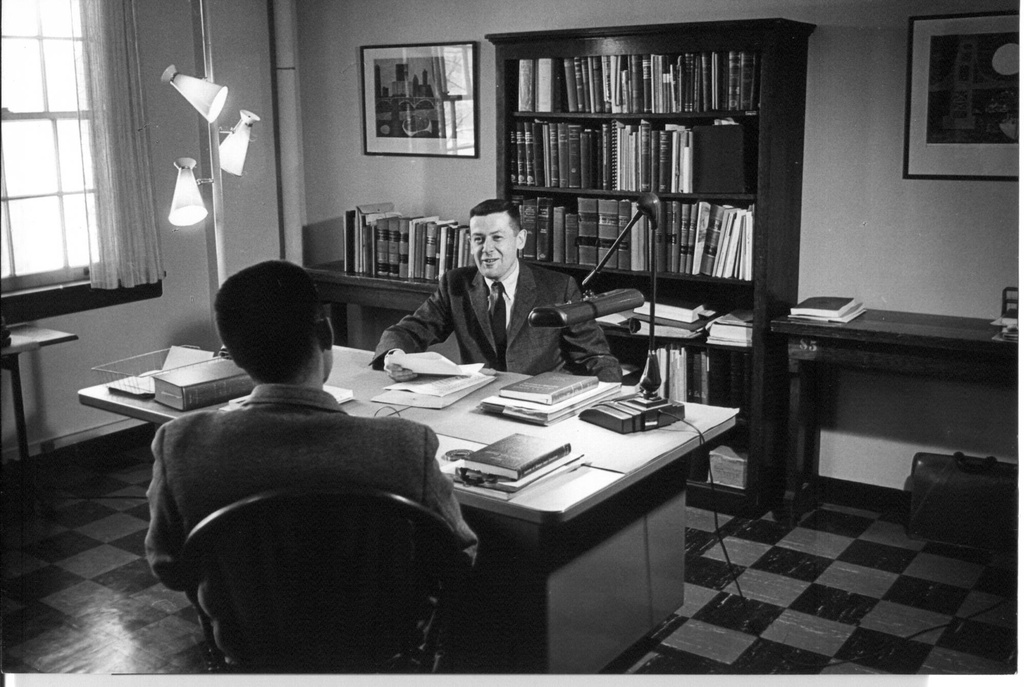
Willard Lee “Sandy” Boyd Jr. was born in St. Paul, Minnesota, on March 29, 1927. He received his Bachelor of Science in Law and Bachelor of Laws degrees from the University of Minnesota, and his Master of Law and Doctor of Juridical Science degrees from the University of Michigan. He practiced law for two years in Minneapolis before joining the UI law faculty in 1954, then served as associate dean of the UI College of Law in 1964, the same year he moved into university administration as vice president of academic affairs.
Boyd served as UI’s 15th president from 1969 to 1981, when he left to become president of the Field Museum of Natural History in Chicago. After retiring from the Field, he returned to the UI as a law professor in 1996 and served as interim president in 2002–03. He formally retired from the university in 2015, though he continued to share his wisdom with any faculty member or administrator who sought him out.
The university grew exponentially during Boyd’s 12-year presidency, adding new buildings, new faculty, and new researchers and expanding its outreach to the state while increasing its national and international stature. His goal, he said, was to make the University of Iowa a premier public university so that all Iowans could access excellent opportunities in higher education.
Over the course of his tenure, undergraduate enrollment increased from 8,400 to 25,100, and he oversaw building projects that nearly doubled the size of campus. Among the more prominent buildings that opened or were planned during Boyd’s tenure:
- Hardin Library for the Health Sciences
- Lindquist Center
- Carver-Hawkeye Arena
- Bowen Science Building
- Dental Science Building
- College of Nursing
One of the biggest physical changes was the growth of University of Iowa Hospitals & Clinics (UIHC), which still was focused around the original 1927 building when Boyd became president. Featuring its well-known Gothic spire, the building was undeniably beautiful but had grown so old it no longer met minimal patient needs.

Boyd and John Colloton, then UIHC’s director, knew the facility had to be improved, but to do so would be expensive and possibly controversial. Their plan cost $500,000, a significant sum in the 1970s, so the university developed a strategy to explain its goals to the Board of Regents, State of Iowa, focusing on the age of the original building.
“Antiquated,” Colloton told the Regents, driving home the point. The building was antiquated.
The Regents listened and raised thoughtful questions. They appreciated the presentation but were naturally wary of spending such a large sum. Then, at a particularly key moment, Colloton says, Boyd spoke up:
“John (Colloton) must refrain from further reference to the present 1927 vintage hospital as being antiquated because, like the hospital, I, too was born in 1927,” Boyd told the Regents.
“This was followed by hearty laughter and had the positive effect of adding a bit of levity to a serious decision-making process,” Colloton says. More important, he says, it relaxed the Regents, who went on to approve the plan that included the construction of what is now called Boyd Tower (named for Boyd in 1981) and, later in his presidency, the Roy J. Carver Pavilion.
Another of Boyd’s early tasks was helping to conceive and establish the UI Foundation (now known as the UI Center for Advancement). In 1955, Boyd was appointed by then president Virgil Hancher to study how fundraising was organized at other Big Ten universities. After extensive research and visits to other institutions, Boyd made his recommendations. The State University of Iowa Foundation was formed in 1956 with the goal of helping the university meet needs beyond those provided for by state support. The foundation raised about $28,000 (approximately $306,000 in 2022) from 1,300 contributors that first year. Both Boyd and his wife, Susan, served on the foundation’s board—Sandy from 1969 to 1981, then again from 2002–03. Susan began serving in 1982 and in 1994 was named lifetime honorary director.
Boyd’s contributions to the university also are enshrined in the Boyd Law Building, which opened in 1986, where he continued to teach after his return to campus in 1996. Yet, as Boyd was always fond of saying, people, not structures make a great university. That’s one of the witty, and often laconic, sayings that Boyd used to express his wisdom. Make your point, then stop talking—a philosophy best summed up by the title of a collection of his commencement addresses published by the UI Center for the Book: Never Too Brief.
“The Iowa taxpayer is the university’s largest unrestricted donor.”
“The river unites us; it doesn’t divide us.”
Thomas Dean, a speech writer for Boyd during his interim presidency, recalls walking on campus when Boyd drove up and poked his head out the window of his car.
“He yelled to me, ‘Tom! People, not structures, make a great university!’” Dean says. “And then he proceeded to turn the corner and drive away.”
Boyd’s presidency was also marked by a commitment to human rights and fairness, and by welcoming people from all races, genders, and cultures to the UI. He hired Phil Hubbard as vice president of student services in 1971, the first Black vice president not only at the UI but in the Big Ten, and May Brodbeck as dean of the faculties (now known as vice president of academic affairs/provost), the first woman to hold that role at the UI and the highest-ranking woman at any co-educational university in the United States at the time.
Boyd’s humanity led him to become a great patron of the arts as well, once boasting that the UI had the largest art collection in the Big Ten and building a museum of art in which to display it. He believed the arts to be at the heart of a university’s educational and research mission.
Boyd’s presidency, being 12 years long, was not without controversy. Growth put pressure on university facilities and the budget, and the campus was rocked by Vietnam War protests in the late 1960s and early 1970s. As with students on other campuses across the country, UI students frequently marched and demonstrated against the war both at the university and at the Boyd family home in Iowa City’s Manville Heights neighborhood. The demonstrations caused serious disturbances, and once, in the spring of 1970, the threat of potential violence prompted university officials to end the semester five days early.
But unlike many other campuses that saw violent riots and buildings set aflame, the protests at the UI led to no deaths or serious injuries.
“In large part, this was because Sandy maintained a high degree of presidential visibility at all times,” says N. William Hines, dean emeritus of the College of Law who became Boyd’s close friend after Hines joined the law faculty in 1964. “He kept in close contact with law enforcement officers, he regularly made himself available to hear the grievances of disgruntled students, and he recruited a group of trusted faculty volunteers to walk the campus to help keep the peace during the peak of the disorders. When the decision was made to shut down the university, the winding up of students’ academic work was handled smoothly.”
In the aftermath, Hines points out that Boyd personally created a disciplinary process to hold disruptive students accountable, which was widely seen as fair and humane.

And Boyd remained available to most anyone, even during the height of the anti-war tumult. He was known across campus for his frequent hand-written thank you notes and small gifts to faculty, staff, and students expressing his appreciation for their work and how well they represented the university.
History professor Linda Kerber remembers receiving such items from Boyd after she joined the faculty in 1971, even though she had not yet met him in person. Sometimes it was a book from his own library, or a magazine with an article he thought she’d find interesting.
“To my dismay now, I realize that I took all this for granted, and I guess I assumed that all university presidents paid such focused attention to junior faculty,” she says. “I did not save his handwritten notes, and I did not save the books or clippings in a way that I can find them again.”
So when Boyd sent her a vintage 1956 copy of Life Magazine devoted to “The American Woman” (Kerber’s work has focused on the history of citizenship, gender, and authority) as he was packing to leave for Chicago in 1981, she made a point to save it.
“I am keeping this treasure carefully, along with Sandy's signed note accompanying it,” Kerber says.
Boyd’s note-writing habit resumed after his return to the university in 1996, and he continued to tell people how impressed he was with their work until his death.
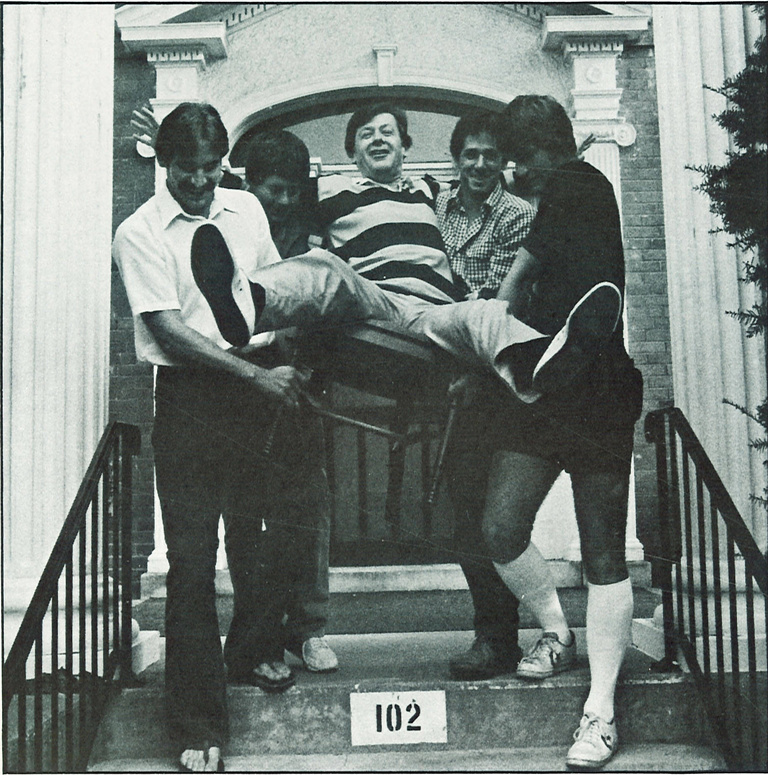
His experience in nonprofit management led Boyd to co-found the Larned A. Waterman Iowa Nonprofit Resource Center in 2001, which works to strengthen the organizations that improve the lives of thousands of Iowans every year. A consulting firm of sorts, the center helps new nonprofits in the state to organize and existing nonprofits to meet their state and federal regulatory obligations.
“Sandy devoted enormous time and energy to the Iowa Nonprofit Resource Center, making it one of the university’s most successful efforts to reach out to citizens of Iowa engaged in charitable activities and volunteer work,” says Hines.
Boyd met his wife, Susan Kuehn Boyd, while living in the Twin Cities, where she worked as a reporter for the Minneapolis Star and Minneapolis Tribune. They married in 1954.
The couple hosted frequent formal and informal gatherings for students and other visitors at the President’s Residence and, before that, their own private home.
“She was incredibly welcoming, made us feel at home, and introduced us to other people,” says law professor Arthur Bonfield, who joined the law faculty in 1962. “She was always the most gracious of hosts.”
Hines remembers the Boyds’ kindness when he arrived to join the law faculty in the summer of 1962, which included the use of their family home for his own young family while the Boyds were vacationing for several weeks.
Though he grew up in St. Paul, Boyd’s introduction to the UI came at a young age. When he was 8, he was present with his father at a ceremony at the Minnesota State Capitol on Nov. 13, 1935, when Iowa Gov. Clyde Herring presented a prize hog from his state’s Rosedale Farms to Minnesota Gov. Floyd B. Olson. The two governors had wagered a hog on the outcome of the previous weekend’s Minnesota v. Iowa football game. Minnesota won 13-6.
The pig, which eventually came to be known as Floyd of Rosedale, made its way for temporary keeping to Minnesota’s agriculture campus where Boyd’s father worked. The younger Boyd remembered seeing the famous pig as he walked past the hog pens, but his memories of what Floyd looked like were sketchy.
“He was a big pig, that’s all I could tell,” Boyd said in 2010 upon Floyd’s 75th anniversary. “He was in a big pen with the rest of the hogs, and he blended in pretty well.”
Floyd’s likeness was eventually cast into a bronze trophy that the Iowa and Minnesota football teams continue to play for every fall.
Boyd, Susan, and their three children also enjoyed spending time at a family vacation home on Madeline Island in Wisconsin’s Apostle Islands on Lake Superior.
Boyd was a member of the American Academy of Arts and Sciences and the American Law Institute. His other public service activities included: trustee of the Roy J. Carver Charitable Trust; chair of the American Association of Universities; chair of the National Museum Services Board; chair of the Council of the Section on Legal Education and Admission to the Bar of the American Bar Association; chair of the Center for Research Libraries (Chicago); chair of the Harry S. Truman Library Institute; chair of Imagine Iowa 2001; president of the National Commission on Accrediting; a member of the National Council on the Arts; the White House Cultural Property Advisory Committee; the advisory board of the Metropolitan Opera; the advisory committee for the Getty Education Institute for the Arts; board member of Americans for the Arts; Elderhostel; and Humanities Iowa.
Boyd was one of the first winners of the Charles Frankel Prize, conferred upon him in 1989 by the National Endowment for the Humanities and honoring five Americans for their efforts to bring history, literature, philosophy, and other humanities disciplines to general audiences. In 1996, Boyd was selected as a laureate by the Lincoln Academy of Illinois and received the Thomas & Eleanor Wright Award, given by the Chicago Commission on Human Relations to individuals whose human relations efforts and activities spanned all interest lines, as well as for making the Field Museum a place where people of different backgrounds come together for a common reason. The Field Museum received the National Award for Museum Service in 1996 from the Institute of Museum Services.
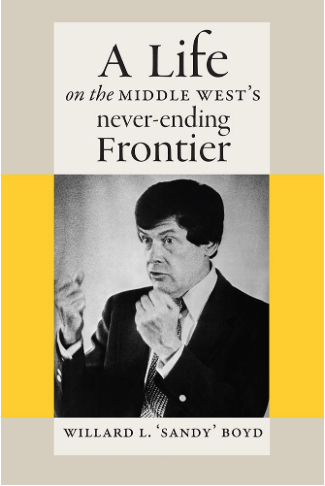
Boyd was the 1998 winner of the Award for Lifetime Services to the Public Humanities, given by Humanities Iowa, the State Humanities Council. In 2012, he received the Richard S. Arnold Award for Distinguished Service and Lifetime Achievement from the Eighth Circuit Bar Association. The UI College of Law’s Boyd Service Award, presented annually to the law student who has performed the most community service, is named in his honor.
In June 2019, University of Iowa Press published Boyd’s memoirs, A Life on the Middle West’s Never-Ending Frontier. Says the book’s description:
“This chronicle of Sandy’s experiences throughout his life shows us the evolution both of the University of Iowa and of the nation writ large. More importantly, this book gives us a lens through which to examine our present situation, whether debating free speech on campus, the role of the arts and humanities in civil society, or the importance of funding for educational and cultural institutions.”
Boyd is survived by his wife, Susan Kuehn Boyd; their three children, Elizabeth “Betsy” Boyd of Iowa City, Willard Lee “Bill” Boyd III of Des Moines, and Thomas Boyd of St. Paul; and seven grandchildren.
